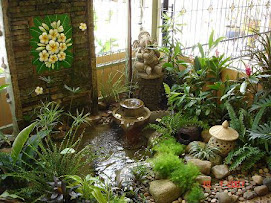Choosing A Tree For A Small Garden
Choosing A Tree For A Small Garden
By John Ingham
Many of us have small gardens and naturally we want to make the most of them. A tree can set the atmosphere of a garden faster than almost anything else and so choosing the right one can be important. If you choose the wrong one you can spend several years being disappointed and more years waiting for a replacement tree to establish itself.
( Garden )
The trees you like best will be entirely a matter of taste and personal association but there are other questions which determine whether they will thrive and look right in the situation which you provide. These are questions of soil conditions, exposure, hardiness, shade, closeness to buildings and boundaries, site lines and final height. With all these factors to consider a good starting point is to see what thrives locally in other gardens and parks. If they do well in your neighbourhood they are more likely to thrive in your garden. You may find it difficult to put a name to a tree which you like. Some public parks and arboretums have labelled their trees making the task much easier for you. It is also my experience that people who enjoy their own gardens will happily share advice, so don't be afraid to ask what the tree in their garden is called and how happy they are with it. In addition there are some excellent books and below I list three which have been useful to me over many years.
The conditions in your garden.
Firstly the soil. Some trees will not thrive in acid soil, some not in thin chalky soils, some will hate wet soils and some soils which are very dry. There are many however which are tolerant of a wide range of conditions and I list a few below. You can test your soil using a test kit from a garden centre or send off a sample to an expert organisaion such as the Royal Horticultural Society. I have never bothered because I can see what does well in my neighbourhood and I know that the soil in my small garden has been cultivated for a hundred years and is a couple of feet of topsoil over clay and limestone. Digging a test hole however will give you an idea of the depth of topsoil (topsoil is the darker soil full of decayed vegetable matter which is at the surface of all natural soils), the amount of clay or rock and the dampness. You shouldn't despair if you only have a couple of feet of soil before you get down to clay or rock. Many trees thrive in this amount and the majority of roots of even large trees tend to be in this top layer.
( Garden )
Hardiness. Within the United Kingdom there is only a limited range of weather conditions but exposure to winds or salt from the sea can greatly effect a tree's chances of survival. Across a continent the size of North America or Europe there is a much greater range of conditions and you may need trees to thrive in the extremes. The books below would give you a good idea of trees for difficult conditions.The Hilliers Manual in particular gives excellent lists of trees and shrubs for many situations and to provide many different effects. Trees for a Small Garden (see below) gives maps of hardiness zones so that you can judge whether a tree is likely to survive.
There are several groups of trees which contain species and varieties suitable for a wide range of conditions and which are unlikely to finish more than 15-30ft high. The most useful are probably Malus (apples including crabs), Prunus (cherries and a large number of related trees), Sorbus (rowans, whitebeams etc), Crataegus (thorns) and Betula (birches). I would add Acers (maples) and Salix (willows) for more particular situations. There are few evergreens amongst these groups and so Ilex (hollies) and smaller conifers may also need consideration.Within these groups is a large selection of many of the most valuable small trees. However, since the selection is so big, you will need to be pointed in the right direction to make your choice. If you don't have the name of a particular tree you will need to either visit an arboretum or other public garden, where trees are labelled for you to judge them, or you will need to look the trees up in books or on the web. There are two outstanding books useful for judging trees (and indeed other plants as well). These are - The Encyclopedia of Plants and Flowers published by the Royal Horticultural Society. This contains brief details of most of the most useful trees and garden plants and photos of a huge number of them. It costs around £30 but could save you from making all sorts of mistakes in choosing the wrong plants. It makes a wonderful present.
The Hillier Manual of Trees and Shrubs which covers most of the plants in these categories commonly grown in gardens. The pocket edition costs around £15.
In addition I use Trees for The Small Garden by Simon Toomer, published by Timber Press. It is around £20 or $30
( Garden )
The Author, John Ingham, works for Impact Plants providing large trees, hedges and living green screens throughout the UK. He also provides free advice.
Impact Plants can be viewed at http://www.impactplants.co.uk
Article Source: http://EzineArticles.com/



No comments:
Post a Comment